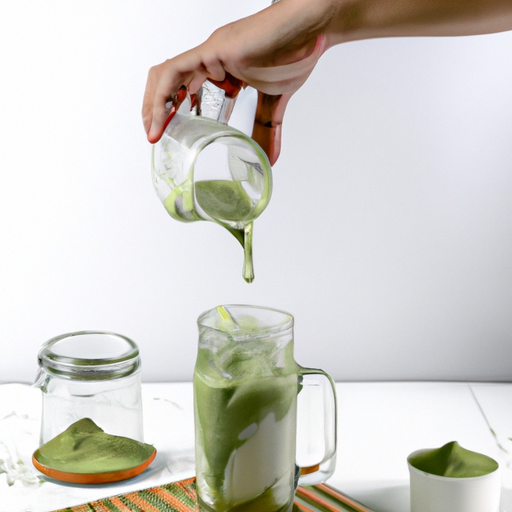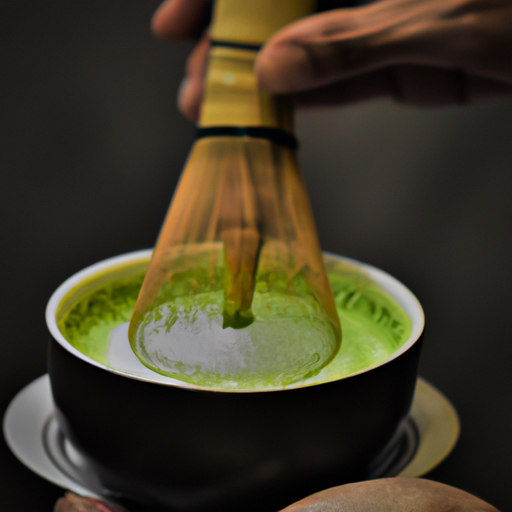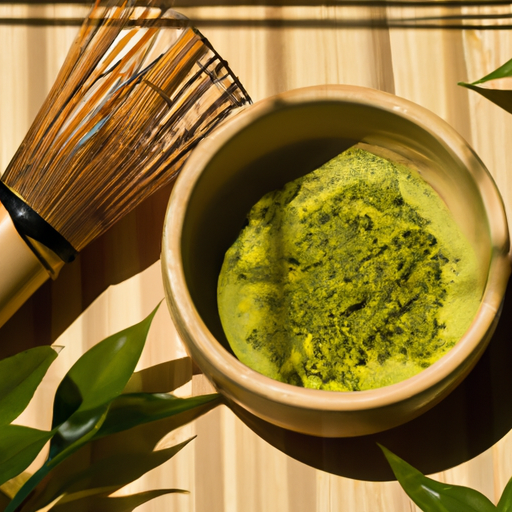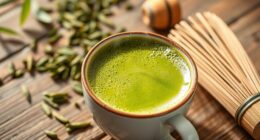I absolutely adore matcha, and sipping on an iced latte made with it tops my list of ways to enjoy it. On sweltering summer days, it serves as the ideal beverage to cool down and rejuvenate, while also being beneficial for your health.
Making an iced matcha latte at home is easy, and with the right ingredients and techniques, you can create a delicious beverage that rivals those from your local coffee shop.
To make an iced matcha latte, all you need are a few key ingredients: high-quality matcha powder, milk (dairy or non-dairy), sweetener (optional), and ice.
The process involves whisking the matcha powder with hot water until it forms a smooth paste, then adding milk and sweetener before pouring over ice.
With just a few steps, you can have a creamy, frothy drink that packs a punch of antioxidants and caffeine to keep you energized throughout the day.
Key Takeaways
- High-quality matcha powder is essential for the best flavor and health benefits in an iced matcha latte.
- Plant-based milk options like almond, oat, coconut, or soy milk can be used in place of dairy milk.
- Adding fruit juice, herbs and spices, and sweet toppings like fresh fruit slices, crushed nuts, and coconut flakes can enhance the appearance and taste of the drink.
- Matcha is a superfood that provides numerous health benefits, including a high concentration of antioxidants and a calming effect on the body due to the amino acid L-theanine.
Ingredients Needed for an Iced Matcha Latte
You’ll need a few simple ingredients to make an incredible iced matcha latte. First and foremost, you’ll want to source high-quality matcha powder for the best flavor and health benefits. Look for ceremonial-grade matcha, which is made from the youngest tea leaves and has a vibrant green color. You can find matcha at specialty tea shops or online retailers.
Next, consider your flavor combinations. Matcha has a slightly bitter taste that pairs well with sweeteners like honey or agave syrup. You could also add vanilla extract or almond milk for extra creaminess. Experiment with different ratios of ingredients until you find your perfect balance of flavors.
With these basic ingredients in mind, let’s move on to the step-by-step instructions for making matcha.
Step-by-Step Instructions for Making Matcha
As you begin your journey to create a frothy green potion, whisk the bright emerald powder with hot water until it forms a velvety smooth paste, like a painter mixing colors on her palette.
Matcha brewing techniques are crucial in achieving the perfect flavor and texture for your iced matcha latte. To ensure proper dissolving of the powder, use water that’s no hotter than 175°F and avoid boiling or simmering the water.
Once you have mixed the matcha into a paste, slowly add cold milk while continuously whisking to create a creamy consistency. Temperature control is important here as well – if the milk is too hot or too cold, it can affect the taste and texture of your drink. It’s best to use milk that’s been chilled in advance so that it doesn’t warm up when added to the matcha mixture.
Now that you’ve mastered making matcha and have achieved a creamy consistency by adding cold milk, let’s move onto tips for choosing the right milk for your iced matcha latte.
Tips for Choosing the Right Milk
Choosing the perfect milk can elevate your matcha experience, creating a luxurious and indulgent treat that’ll leave you feeling satisfied.
When it comes to making an iced matcha latte, there are plenty of plant-based options and dairy alternatives to choose from. You can use almond milk, oat milk, coconut milk, or soy milk depending on your preference.
When selecting the right milk for your iced matcha latte, it’s important to consider how the flavor profile of each option will complement the taste of your matcha powder.
Almond milk has a nutty taste and is naturally sweet, making it a great choice for those who prefer a sweeter drink. Oat milk has a mild flavor and creamy texture, which makes it ideal if you want to add more body to your latte.
If you’re looking for something with less fat content or lactose-free, then soy or coconut milk may be better options for you. Soy milk has an earthy flavor while coconut milk adds richness and enhances the tropical flavors in your matcha beverage.
Ultimately, choosing the right type of milk boils down to personal preference, so feel free to experiment until you find what works best for you!
Now let’s move on to some tips for choosing the right matcha powder without missing anything important.
Tips for Choosing the Right Matcha Powder
To ensure the best quality matcha powder, it’s important to consider factors such as origin, grade, and color. Matcha grades vary in terms of quality and flavor profiles. The highest grade is ceremonial matcha, which has a rich umami flavor and bright green color.
Culinary matcha is another option that is slightly lower in quality but still suitable for use in drinks like an iced matcha latte. When choosing matcha powder for your latte, consider the flavor profile you prefer. Some people enjoy a stronger, more bitter taste while others prefer a milder flavor.
Additionally, pay attention to the color of the powder – brighter greens typically indicate higher quality matcha. Incorporating high-quality matcha into your iced latte can make all the difference in terms of taste and overall experience.
Now that we’ve covered how to choose the right powder, let’s move on to tips for sweetening your drink without adding too much sugar or calories.
Tips for Sweetening Your Iced Matcha Latte
Looking for a healthier way to sweeten your refreshing green drink? But how can you add sweetness without adding sugar or calories? The answer is alternative sweeteners.
These sweeteners are becoming more popular in the food industry as they offer a healthy option for those who want to reduce their sugar intake. Some examples of alternative sweeteners include honey, maple syrup, agave nectar, and stevia.
You can also add some flavor additions to your iced matcha latte instead of relying on traditional sweeteners. Vanilla extract or almond milk will provide a subtle sweetness that complements the natural taste of matcha. You could also try adding a pinch of cinnamon or nutmeg for an extra kick of flavor.
Now that you have some ideas on how to naturally sweeten your iced matcha latte, let’s move onto discussing the variations you can make with this delicious drink. From coconut milk to mint leaves, there are countless ways to customize your iced matcha latte and make it your own unique creation.
Variations of the Iced Matcha Latte
You’ll be thrilled to discover the endless array of possibilities when it comes to creating your own unique version of this refreshing green beverage. There are countless ways to add your personal touch and elevate the flavor profile of an iced matcha latte.
Here are a few ideas to get you started:
- Add a splash of fruit juice: A small amount of lemon, lime, or orange juice can provide a tangy twist that complements the matcha’s natural bitterness.
- Experiment with herbs and spices: Mint, ginger, cinnamon, or cardamom can all work wonders in an iced matcha latte. Just be sure not to overpower the delicate tea flavor.
- Top it off with something sweet: Whipped cream, honey drizzle, or caramel sauce can add a decadent touch to your drink while balancing out any bitter notes.
When crafting your perfect iced matcha latte, don’t forget about toppings! The best ones enhance both the appearance and taste of your drink. Some popular options include:
- Fresh fruit slices: Strawberries, blueberries, or raspberries not only look beautiful on top of an iced matcha latte but also bring complementary flavors.
- Crushed nuts: Almonds, pecans, or cashews provide a crunchy texture that pairs well with the smoothness of matcha.
- Coconut flakes: Toasted coconut flakes add an exotic flair while giving off subtle sweetness.
With so many variations available for you to explore, it’s easy to make an iced matcha latte that perfectly suits your taste buds. And as if great flavors weren’t enough reason already, next we’ll discuss how drinking this tea can benefit your health!
Health Benefits of Matcha
Did you know that incorporating matcha into your diet can provide numerous health benefits? Matcha is a type of green tea that has been consumed for centuries in Japan and is known for its high concentration of antioxidants. It is also rich in vitamins, minerals, and amino acids that can boost your overall well-being. In this section, I will discuss the health benefits of matcha and how it can be incorporated into your daily routine.
Matcha contains a unique class of antioxidants called catechins, which are known to help protect against cell damage caused by free radicals. These powerful antioxidants can help prevent chronic diseases such as cancer, heart disease, and diabetes. Additionally, matcha has a calming effect on the body due to the amino acid L-theanine present in it. This makes it an excellent alternative to coffee for those who want to stay alert without feeling jittery.
One way to incorporate matcha into your diet is through matcha recipes such as smoothies or lattes. However, if you don’t enjoy the taste of matcha or find it difficult to prepare, you can also take matcha supplements in capsule form. These supplements provide all the same health benefits as drinking matcha but are more convenient for those with busy schedules or on-the-go lifestyles. Regardless of how you choose to consume it, adding matcha to your daily routine is an easy way to improve your overall health and well-being.
| Health Benefits | Description |
|---|---|
| High concentration of antioxidants | Protects against cell damage caused by free radicals |
| Rich in vitamins and minerals | Boosts overall well-being |
| Calming effect on the body | Alternative to coffee without jitters |
| Prevents chronic diseases | Such as cancer, heart disease & diabetes |
| Can be taken through supplements | Convenient option for busy individuals |
Incorporating matcha into your diet provides numerous health benefits that can help improve your overall well-being. From its high concentration of antioxidants to its calming effect on the body, matcha is a superfood that should be added to everyone’s daily routine. Whether you choose to consume it through matcha recipes or supplements, there are numerous ways to enjoy the benefits of this superfood. So why not add a little green tea goodness to your life and see the difference it can make?
Frequently Asked Questions
How long does it take to make an iced matcha latte?
I used to think that making an iced matcha latte was a time-consuming process, but I’ve since discovered a quick recipe that I love.
It only takes me about 5 minutes to make from start to finish! To get the perfect froth on top, I suggest using a milk frother or blender.
This will ensure that your latte is creamy and frothy without any clumps of matcha powder. Another tip for achieving the perfect flavor is to use high-quality matcha powder and sweetener of your choice (if desired).
Overall, with just a few simple steps and some helpful tips, anyone can make an amazing iced matcha latte in no time.
Can I use any type of milk for my matcha latte?
Yes, you can use any type of milk for your matcha latte, but some types work better than others. Personally, I prefer using almond milk as an alternative to traditional dairy milk because it adds a slightly nutty flavor that complements the earthy taste of matcha.
When making a latte with almond milk or any other non-dairy alternative, it’s important to use frothing techniques that will create a creamy texture without separating the milk. This can be achieved by heating the milk in a small saucepan and then whisking vigorously until frothy or by using an electric frother.
Overall, experimenting with different milks and frothing techniques is key to finding the perfect matcha latte recipe that suits your personal taste preferences.
What is the difference between ceremonial grade matcha and culinary grade matcha?
When it comes to matcha, there are two main grades: ceremonial and culinary. The difference lies in the quality of the leaves used to make the powder.
Ceremonial grade matcha is made from young tea leaves that are hand-picked, steamed, dried, and then ground into a fine powder. It has a vibrant green color, delicate flavor profile with subtle sweetness and umami notes.
On the other hand, culinary grade matcha is made from slightly older leaves that are more bitter and astringent than ceremonial grade. It’s less expensive than ceremonial grade and typically used for cooking or blending into drinks where its robust flavor can hold up against other ingredients.
While both grades of matcha have their use cases, if you want a truly authentic matcha experience with a nuanced flavor profile, go for ceremonial grade every time.
Can you make an iced matcha latte without sweetener?
No sweetener: Yay or nay? Personally, I think it depends on your taste preferences. Some people enjoy the natural bitterness of matcha and don’t feel the need to add any sweetener. However, others might find it too overpowering without a little bit of sweetness added in.
Health benefits-wise, matcha is already packed with antioxidants and other nutrients that are great for your body. Adding sweetener can counteract some of those health benefits and add unnecessary calories to your drink.
Ultimately, it’s up to you whether or not you want to add sweetener to your iced matcha latte. Just remember that if you do choose to add it in, try to use a natural sweetener like honey or maple syrup instead of processed sugar.
How many calories are in an iced matcha latte?
As the saying goes, "you’re what you eat."When it comes to an iced matcha latte, there are benefits and alternatives to consider.
Matcha is a type of green tea that contains high levels of antioxidants and may boost metabolism. However, ordering an iced matcha latte at a coffee shop or making one at home with added sweeteners and milk can quickly add up in calories.
Depending on the recipe or store-bought version, an iced matcha latte can range from around 100 to over 400 calories. If you’re looking for lower calorie alternatives, consider using unsweetened almond or coconut milk and skipping any added sweeteners altogether.
Conclusion
In conclusion, making an iced matcha latte at home is easy and can be customized to your liking. You can create a refreshing drink that not only tastes great but is also packed with health benefits. Whether you prefer your matcha latte sweetened or unsweetened, with dairy milk or a plant-based alternative, there are endless possibilities for personalizing this beverage.
As the saying goes, "You’re what you eat."By incorporating matcha into your diet, you’re giving yourself a boost of antioxidants and other beneficial nutrients. So why not treat yourself to an iced matcha latte today? Not only will it satisfy your cravings for something sweet and cold, but it’ll also give you the energy and nourishment your body needs to tackle whatever comes next.
Cheers to good health!










